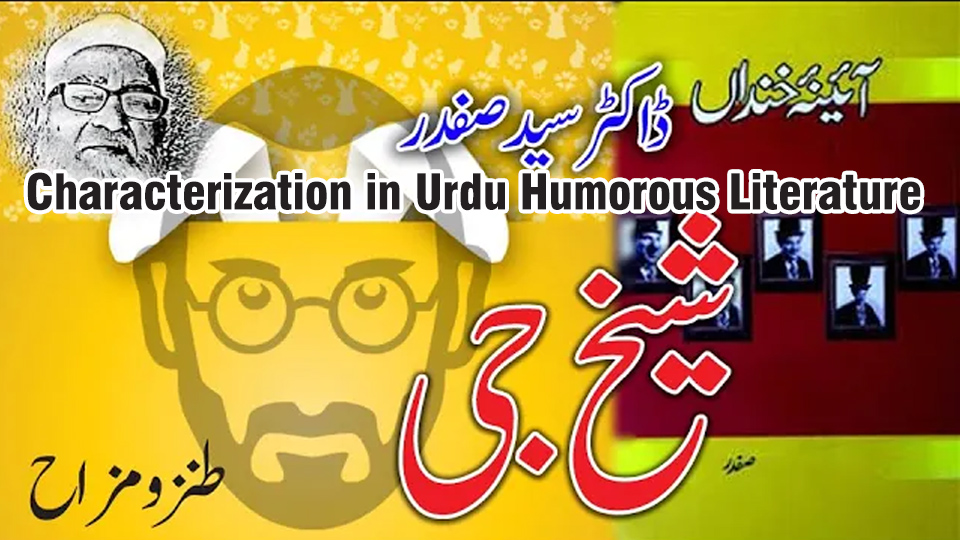Characterization in Urdu humorous literature is not just a source of entertainment—it’s a subtle yet powerful mirror to society. It brings human flaws, cultural contradictions, and psychological behaviours to life in a way that makes the reader laugh, reflect, and question simultaneously. This form of writing doesn’t merely aim to amuse, but also to provoke thought through satire and clever observation. Among the many memorable characters in this tradition, the fictional yet strikingly real “Sheikh Ji” created by Dr. Syed Safdar Hussain stands out as a timeless example of effective literary characterization.
The Art of Characterization in Urdu Humorous Literature
Characterization in Urdu humorous literature is an intricate art. Writers do more than create funny people—they build personalities that echo the quirks and eccentricities of real individuals. These characters are exaggerated mirrors of people we meet daily: the overly wise neighbour, the self-proclaimed poet, or the all-knowing elder. Each personality is a vehicle for humor, satire, and critique.
One of the prime functions of these characters is to unmask societal pretensions. Through light-hearted storytelling, authors often highlight contradictions in public behaviour, misuse of religious or cultural authority, and hypocritical social norms.
Sheikh Ji: A Character that Lives Beyond the Page
In Dr. Syed Safdar Hussain’s book Aina-e-Khandan, the character Sheikh Ji is a standout creation. This fictional personality combines common social behaviours into one delightfully exaggerated individual. Sheikh Ji is the kind of person who believes he is an expert on everything—from religion and politics to food and fashion. His conversations are laced with arrogance, self-deception, and unintentional irony.
Characterization in Urdu humorous literature finds its pinnacle in Sheikh Ji. He is not just a single character; he is a representation of many. His self-important manner, flawed logic, and boastful stories form a familiar yet humorous profile that readers can easily associate with someone in their community.
Literary Brilliance of Dr. Syed Safdar Hussain
Dr. Safdar Hussain was more than just a humorist. Born in 1919 in Muzaffarnagar (British India), he later moved to Pakistan and contributed significantly to Urdu literature as a scholar, poet, historian, and critic. His writings, such as Aina-e-Zindan, Shairi aur Shewa-e-Payghambari, and Zikr-e-Shahriaran, show his command over multiple genres. However, his humorous prose in Aina-e-Khandan remains unmatched for its wit, satire, and character portrayal.
The way Dr. Hussain brings Sheikh Ji to life is nothing short of literary craftsmanship. With playful yet pointed language, he sketches a character that is at once amusing and thought-provoking. Readers laugh, but they also recognize the hypocrisies embedded in society.
Sheikh Ji as a Satirical Symbol
Sheikh Ji is more than just a fictional persona. He is a cultural critic wrapped in comic relief. His behaviour exposes a mindset common among those who speak loudly but act little. His flamboyant views, exaggerated claims, and everyday wisdom—often incorrect or inflated—reveal how easily people can live in delusions of grandeur.
Characterization in Urdu humorous literature serves as a satirical tool here. Through Sheikh Ji, the author holds a mirror up to those who dominate conversations but contribute little substance. It’s a humorous yet honest portrayal of superficial intellect and empty pride.
Lasting Impact on Urdu Humorous Literature
Sheikh Ji remains one of the most memorable characters in Urdu humorous literature. His charm lies in his relatability, his comic flaws, and the sharp satire underlying his actions. The character is not just funny; he’s meaningful. He encourages readers to identify similar behaviours around them—and perhaps, within themselves.
Such characters enrich Dr. Safdar Hussain’s legacy. Aina-e-Khandan is now considered a cornerstone in Urdu comic prose, and Sheikh Ji is its most enduring jewel.
Conclusion
Characterization in Urdu humorous literature is a compelling blend of humor, insight, and social commentary. Through characters like Sheikh Ji, writers like Dr. Syed Safdar Hussain don’t just entertain—they enlighten. The beauty of such literature lies in its dual power to make us laugh and reflect, often at the same time.
If you’re interested in reading this book online, click the link below for a free download.
https://www.rekhta.org/ebooks/aaina-e-khandan-safdar-ebooks?lang=ur
If you’d like to listen to this book in audio format, click the CONTACT button below to get in touch with the AwazeUrdu team to order the audiobook.
You can also watch the same video on these social media platforms.
اردو مزاحیہ ادب میں کردار نگاری ایک اہم فن ہے جو قاری کو نہ صرف محظوظ کرتا ہے بلکہ طنز و مزاح کے ذریعے معاشرتی رویوں پر روشنی بھی ڈالتا ہے۔ ان کرداروں کے ذریعے مصنفین عام انسانوں کی کمزوریوں، تضادات اور رویّوں کو اس انداز میں پیش کرتے ہیں کہ قاری ہنسنے کے ساتھ سوچنے پر بھی مجبور ہو جاتا ہے۔ ایسے ہی مزاحیہ کرداروں میں ایک اہم اور قابلِ ذکر کردار “شیخ جی” کا ہے، جو ڈاکٹر سید صفدر حسین کا تخلیق کردہ ہے۔ یہ کردار اُن کے مزاحیہ مجموعے آئینہء خنداں میں شامل ہے اور اردو نثر میں کردار نگاری کی ایک دلکش مثال پیش کرتا ہے۔
ڈاکٹر سید صفدر حسین اردو ادب کے ممتاز محقق، نقاد، شاعر، مؤرخ اور بالخصوص مرثیہ نگار تھے۔ ان کی علمی و ادبی خدمات نے اردو زبان کے کئی گوشوں کو نکھارا۔ وہ 1919 میں مظفرنگر (برطانوی ہندوستان) میں پیدا ہوئے اور بعد ازاں پاکستان آ کر تدریس و تحقیق کے شعبے سے وابستہ ہو گئے۔ ان کی زندگی کا بیشتر حصہ تعلیم و ادب کے فروغ میں گزرا۔ ان کی تصانیف میں آئینۂ زنداں، شاعری اور شیوۂ پیغمبری، ذکرِ شہریاراں اور نگارِ غزل جیسی اہم کتابیں شامل ہیں۔ ان کی وفات 15 جنوری 1980 کو اس وقت ہوئی جب وہ منبر پر مرثیہ پڑھ رہے تھے، جو ان کے فن سے عشق کا روشن ثبوت ہے۔
ڈاکٹر صفدر حسین کی کتاب آئینہء خنداں اردو نثر میں مزاحیہ تحریروں کا قیمتی سرمایہ ہے۔ اس میں شامل مضامین مزاح کو صرف ہنسی تک محدود نہیں رکھتے، بلکہ تہذیبی، معاشرتی اور نفسیاتی پہلو بھی اپنے اندر سموئے ہوئے ہیں۔ ان کے اندازِ تحریر میں انشائیے کا سا بانکپن اور اسلوب میں تخلیقی سادگی پائی جاتی ہے۔ انہی مزاحیہ تحریروں میں سے ایک دلچسپ اور یادگار مضمون “شیخ جی” ہے، جس کا مرکزی کردار نہایت دلچسپ، متحرک اور فطری محسوس ہوتا ہے۔
مضمون “شیخ جی”ایک فرضی مگر حقیقت سے قریب تر کردار کا خاکہ ہے، جو ہماری روزمرہ زندگی میں بکھرے کئی افراد کا مجموعہ محسوس ہوتا ہے۔ شیخ جی ایک ایسے بزرگ ہیں جو خود کو ہر فن مولا سمجھتے ہیں۔ وہ اپنے آپ کو دین، سیاست، تہذیب، شاعری، کھانے، کپڑے اور دنیا کے ہر موضوع پر صاحبِ رائے سمجھتے ہیں۔ ان کی گفتگو میں خود پسندی، خود فریبی، اور طنز کی چاشنی پائی جاتی ہے۔
مصنف نے شیخ جی کے ذریعے معاشرے کے ان کرداروں کو آئینہ دکھایا ہے جو باتیں تو بڑی کرتے ہیں، مگر عملی زندگی میں ان کی حیثیت محض الفاظ کے شور سے زیادہ نہیں ہوتی۔ شیخ جی کے ظاہری رکھ رکھاؤ، باتوں کے انداز، اور اُن کے خود ساختہ فلسفوں پر مبنی روزمرہ کے تجربات کو ڈاکٹر صاحب نے نہایت دلکش، شوخ اور چٹکیلی زبان میں بیان کیا ہے۔ قاری ہنستا ہے، محظوظ ہوتا ہے، اور کہیں نہ کہیں شیخ جی کی جھلک اپنے آس پاس کے ماحول میں محسوس بھی کرتا ہے۔
مضمون “شیخ جی” صرف ایک مزاحیہ خاکہ نہیں، بلکہ اردو ادب میں کردار نگاری کی ایک کامیاب مثال بھی ہے۔ ڈاکٹر سید صفدر حسین نے اپنے تخلیقی فن، مشاہداتی بصیرت اور شگفتہ زبان کے ذریعے “شیخ جی” جیسے کردار کو ہمیشہ کے لیے زندہ کر دیا ہے۔ ان کی کتاب آئینہء خنداں اردو نثر کے مزاحیہ ادب میں ایک اہم سنگِ میل ہے، اور “شیخ جی” اس کتاب کا سب سے نمایاں اور پُراثر کردار ہے۔ یہ تحریر قاری کو نہ صرف ہنساتی ہے بلکہ معاشرتی رویوں پر تنقیدی نظر ڈالنے کی تحریک بھی دیتی ہے۔

